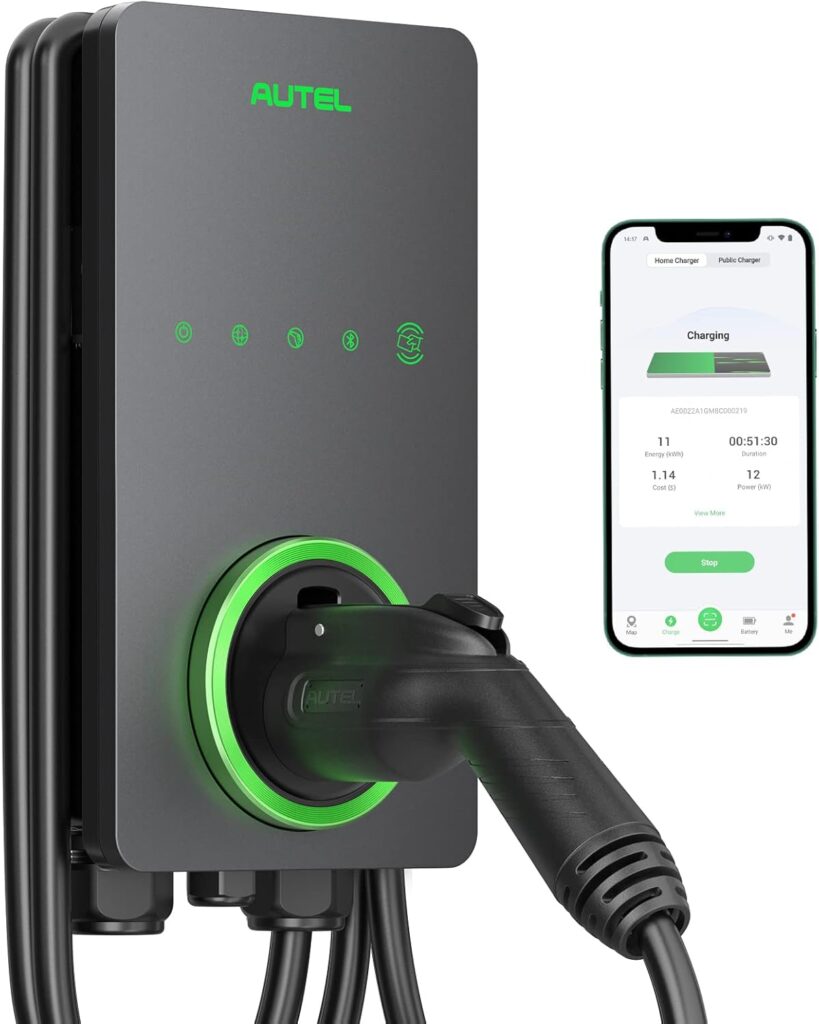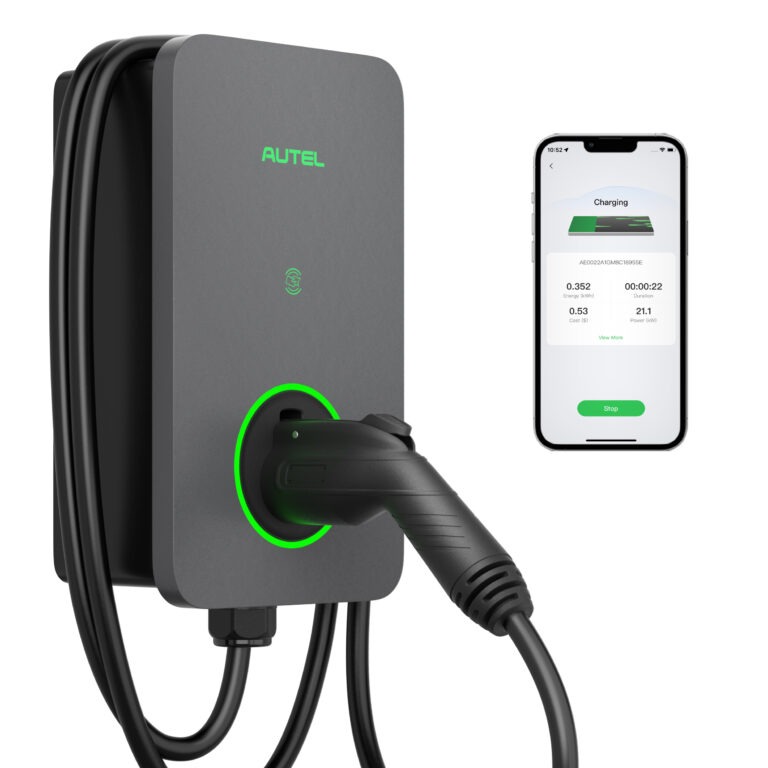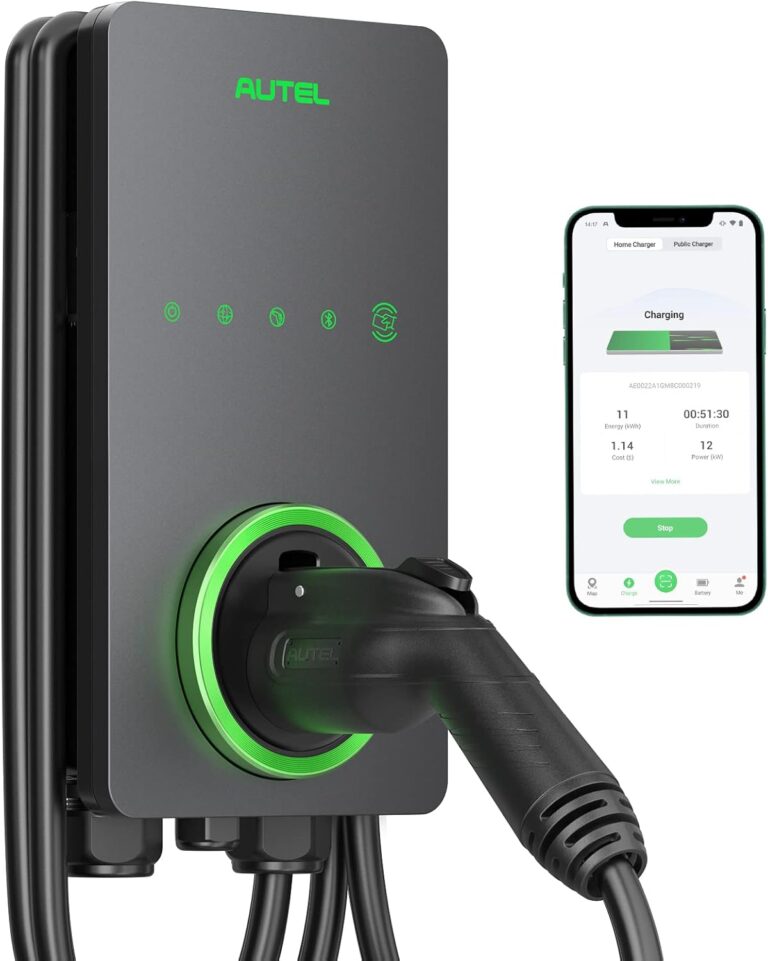
Autel MaxiCharger 50A Review!
Some of the links in this article are affiliate links, which means we earn a commission if you click through and make a purchase – at no extra cost to you.
Autel MaxiCharger 50A - What Is It?
Electric vehicles (EVs) are becoming increasingly mainstream, and with that growth comes a greater need for convenient and efficient home charging solutions. While Level 1 charging (using a standard 120V outlet) is an option, it’s often too slow for most EV owners. Level 2 charging, using a 240V outlet, offers significantly faster charging speeds, making it the preferred choice for overnight or daily top ups.
The Autel MaxiCharger 50A is one of the most popular Level 2 EV charger designed for home use. It promises a blend of speed, smart features, and reliability. But is it the right choice for you?
This comprehensive review will delve into all aspects of the Autel MaxiCharger, providing the information you need to make an informed decision.
Table of Contents
Autel MaxiCharger 50A
Autel MaxiCharger 50A Review
- Charging Speed: 50 Amps (Adjustable to lower amperage levels based on circuit capacity). 240V (Requires a dedicated 240V circuit).
- Compatibility: SAE J1772. Compatible with most Level 2-capable EVs, including Tesla (with adapter), Chevy Bolt, Ford Mustang Mach-E, Nissan LEAF, Hyundai Kona Electric, Kia Niro EV, and many more.
- Warranty: 3 years
- Smart Features: Yes Remote monitoring of charging status. Charging scheduling (take advantage of off-peak electricity rates). Charging history and energy consumption data. Over-the-air (OTA) firmware updates. Remote start/stop charging. Adjustable charging current
- Installation Time: 2-4 hours for a qualified electrician
- Cable Length: 25 feet
- Reviews: 983 / 4.5 Stars
The Autel MaxiCharger 50A is a powerful Level 2 EV charger designed to bring fast and convenient charging to your home. Built upon Autel’s extensive experience in automotive diagnostics, the MaxiCharger aims for reliability and smart functionality. Its core strength lies in its 50 amp output, which allows for significantly faster charging compared to standard Level 1 chargers or lower amperage Level 2 options. This makes it ideal for EV owners who need to replenish their battery quickly, especially overnight.
Beyond its speed, the MaxiCharger stands out with its smart features powered by the Autel app. This allows users to monitor charging progress, schedule charging sessions to coincide with off peak electricity rates, and track their energy consumption over time. The app also facilitates over the air firmware updates, ensuring the charger stays up to date with the latest features and improvements.
Available in both hardwired and plug-in configurations (NEMA 14-50), the MaxiCharger offers flexibility in installation. However, proper installation by a qualified electrician is crucial, particularly for the hardwired option, to ensure safety and compliance with local electrical codes. Its NEMA 4 enclosure provides weather resistance, making it suitable for both indoor and outdoor use.
The amperage rating of an EV charger determines the amount of electrical current it can deliver to the vehicle. Higher amperage translates to faster charging speeds. While a standard 120V Level 1 charger might add only 3-5 miles of range per hour, a 240V 50A charger like the Autel MaxiCharger can add 30 to 40 miles of range per hour. The actual range added per hour depends on the specific EV model, its battery capacity, and its charging efficiency.
Compatible with all electric vehicles that use a J1772 connector (most EVs).
Dedicated 240V Circuit: Requires a dedicated 240V circuit with sufficient amperage (typically 60 amps for a 50-amp charger).
Professional Installation Recommended: Hardwired installation should always be performed by a qualified electrician. Even for plug in installation, ensure the existing outlet is properly wired and grounded.
Permitting: Check local building codes and permitting requirements for EV charger installations.
Circuit Breaker: The circuit breaker must be appropriately sized for the charger’s amperage rating.
Wiring: Use appropriate gauge wiring for the amperage and distance of the circuit.
Fast Charging: 50 amp output provides significantly faster charging speeds than lower-amperage chargers.
Smart Features: Autel app offers remote monitoring, scheduling, and energy tracking.
Reliable Brand: Autel is a reputable name in automotive diagnostics.
Weatherproof Design: NEMA 4 enclosure allows for indoor or outdoor installation.
Versatile Installation: Offers both hardwired and plug in options.
Higher Cost: Typically more expensive than lower-amperage chargers.
Professional Installation May Be Required: Adds to the overall cost.
App Dependency: Relies on the Autel app for many of its smart features, which may be a concern for users who prefer not to use a smartphone app.
Potential Compatibility Issues While it boasts universal compatibility, some users have reported occasional issues with specific vehicle models requiring troubleshooting. Always check the Autel support documentation.
You need fast charging at home: If you have a long commute or frequently deplete your EV’s battery, the 50 amp output is a significant advantage.
You want smart charging features: The Autel app provides valuable insights into your charging habits and allows you to optimize your charging schedule.
You have the electrical infrastructure in place: Ensure you have a dedicated 240V circuit with sufficient amperage.
You value reliability and a reputable brand: Autel’s experience in automotive diagnostics provides confidence in the quality and reliability of the MaxiCharger.
You’re prepared for professional installation (if needed): Factor in the cost of professional installation when budgeting for the charger.
What are the differences between Level 1, Level 2, and level 3 EV Chargers?
Level 1 uses a standard 120V outlet and offers the slowest charging speed (3-5 miles of range per hour).
Level 2 utilizes a 240V outlet, significantly increasing charging speed (20-40 miles of range per hour).
Level 3 (DC Fast Charging) is the fastest, employing high voltage DC power for public charging (50-200+ miles of range per hour).
Why is A level 2 EV charger better than level 1?
Level 2 charging offers numerous significant advantages over Level 1:
Significantly Faster Charging Speeds: This is the primary benefit. Level 2 charging can replenish your battery up to 10 times faster than Level 1.
Convenient Overnight Charging: You can fully recharge your EV overnight, ensuring a full battery every morning for your commute or errands.
Increased Range Confidence: With faster charging, you can top off your battery more quickly, reducing range anxiety.
Reduced Reliance on Public Charging: Home Level 2 charging allows you to minimize the need to visit public charging stations, which can be inconvenient and costly.
Cost Savings (Potentially): Charging at home during off peak hours can often be cheaper than using public charging stations.
Enhanced EV Ownership Experience: Level 2 charging makes EV ownership more seamless and enjoyable, removing the hassle of slow charging.
Higher Resale Value: Having a Level 2 charger installed at your home can increase the resale value of your property, especially in areas with a growing EV adoption rate.
Why is a Level 3 EV Charger (DC Fast Charger) Better Than a Level 2 Charger?
Level 3 EV chargers, also known as DC Fast Chargers (DCFC), are generally considered “better” than Level 2 chargers in specific situations where speed is the primary concern. The key advantages of Level 3 charging stem from their significantly faster charging speeds:
Ultra Fast Charging Speeds: Level 3 chargers deliver DC (Direct Current) power directly to the EV battery, bypassing the EV’s onboard charger. This allows for much higher charging rates compared to Level 2 chargers, which use AC (Alternating Current) power. Level 3 chargers can typically add 50-200+ miles of range in just 30-60 minutes, whereas a Level 2 charger might take several hours to add the same amount of range.
Example: A Level 3 charger might add 80% charge to an EV battery in 30 minutes, while a Level 2 charger might take 6-8 hours to achieve the same result.
Ideal for Long Trips and Roadside Charging: Level 3 chargers are primarily found at public charging stations along highways and in urban areas. They are ideal for quickly replenishing your EV’s battery during long road trips or when you need a quick charge while you’re out and about.
Enabling EV Adoption: Level 3 charging infrastructure plays a crucial role in supporting wider EV adoption by reducing range anxiety and making long-distance travel more practical for EV owners.

Who Are Autel Energy?
Autel’s extensive background in automotive diagnostics significantly influences the design and reliability of their EV chargers. Since its inception in 2004, Autel has been a prominent figure in the automotive industry, renowned for its advanced diagnostic tools used by professionals worldwide.
Autel’s background in vehicle diagnostics gives them a unique edge in building EV chargers. They’ve spent years developing tools that read and interpret complex data from cars, including battery systems. That experience carries over into their chargers, which aren’t just about delivering power, they’re built to interact intelligently with your vehicle. Some models include features that monitor battery health and adjust charging based on what the car actually needs. It’s the kind of attention to detail you’d expect from a company that understands EVs from the inside out. Autel Energy
Moreover, Autel’s commitment to innovation is evident in their development of the MaxiSys Ultra EV diagnostic tablet, which offers comprehensive analysis of electric and hybrid vehicles, including battery pack diagnostics and state of charge assessments. This level of integration between diagnostics and charging ensures that their EV chargers are not only reliable but also optimized for the longevity and efficiency of the vehicle’s battery system.
In addition to the 50A home charger, Autel offers a wide range of EV charging solutions that show their commitment to the growing EV market. Their lineup includes lower amperage home chargers like the 40A and 32A MaxiChargers for households with more limited electrical capacity. For businesses, Autel provides commercial grade chargers such as the DC Fast Chargers, capable of rapid charging in public or fleet settings. They also offer portable EV chargers compact units designed for on the go use or as a backup solution. This broad range highlights Autel’s focus on serving both everyday drivers and large scale commercial operations.
Autel 50A EV Charger Battery Range And Cost Calculator
How fast does the Autel MaxiCharger 50A charge?
The 50A output allows for faster charging than lower amperage chargers, potentially adding 30 40 miles of range per hour. For instance, a Tesla Model 3 (Long Range) can gain approximately 37 miles of range per hour, while a Chevrolet Bolt might gain around 30 miles. These are estimations, and actual results depend on factors like battery size, temperature, and charging efficiency.
What can I do with the Autel app?
The Autel app offers remote monitoring of charging status, scheduling charging sessions (to optimize electricity costs during off-peak hours), viewing detailed charging history and energy consumption data, adjusting the charging amperage (to match your circuit capacity), and receiving real-time notifications.
Are Autel MaxiCharger 50A Chargers Safe?
Safety wise, the MaxiCharger checks all the right boxes. It’s UL listed (UL 2594 and UL 2231), so you know it’s been through proper testing and won’t cause problems if installed correctly. The weatherproof housing is rated NEMA 4, which basically means it’s good to go whether you’re mounting it in a garage or out on the side of the house. As for the cable, it’s 25 feet long, enough to reach most cars without having to pull in perfectly every time.
Autel MaxiCharger 50A Charger Specs
Amperage: 50 Amps (adjustable in the app to lower settings for compatibility with 40A, 32A, or lower circuits)
Voltage: 240V
Connector Type: SAE J1772 (universal compatibility with most EVs in North America, requires adapter for Teslas)
Installation: Hardwired or NEMA 14-50 plug-in option
Dimensions & Weight:
Size: 13.5″ x 7.6″ x 3.3″ (H x W x D)
Weight: Around 13.5 lbs
Operating Temperature: Rated for: -22°F to 131°F (-30°C to 55°C)
Do I need an electrician to install the Autel MaxiCharger 50A Charger?
Yes, you’ll definitely want a licensed electrician to install the Autel MaxiCharger, especially since it’s a hardwired unit and pulls up to 50 amps of current. This isn’t a simple plug-and-play setup, and doing it wrong can cause serious problems.
Why You Need a Pro
Hardwiring a high-amperage EV charger means connecting it directly to your home’s electrical panel. That involves:
Running a dedicated circuit
Installing a 60-amp breaker (to safely support 50 amps continuous load)
Ensuring the electrical panel has enough capacity
An electrician will make sure your system can handle the charger safely without overloading circuits or risking fire hazards.
Permits & Inspections
In many areas, this kind of installation requires a permit, and it may need to be inspected afterward to meet local codes. Skipping this step could cause issues with insurance or home resale down the line. Requirements vary, so check with your local building department.
Cost to Install
Professional installation typically costs $300–$800, depending on factors like:
Distance from the electrical panel
Whether trenching or conduit is needed
Panel upgrades (if required)
Local labor rates
If your panel is already EV-ready, it’ll be on the lower end. If your panel is full or far from where the charger will go, expect to pay more.
Don’t DIY This One
Even if you’re handy, don’t try to install this charger yourself unless you’re a licensed electrician. You’re dealing with high voltage and high current. Mistakes can lead to electric shock, fire, or serious damage to your home’s electrical system; not to mention voiding your warranty or breaking code.
How long will it take to charge my EV with the Autel MaxiCharger 50A Charger?
The Autel MaxiCharger 50A delivers up to 12 kW of power, which can add approximately 20 to 60 miles of range per hour, depending on your EV’s onboard charger capacity and battery size.
Here are some examples:
Tesla Model 3 Long Range (82 kWh battery): With an 11.5 kW onboard charger, you can expect to add about 44 miles of range per hour, reaching a full charge in roughly 7–8 hours.
Ford Mustang Mach-E (91 kWh battery): Equipped with a 10.5 kW onboard charger, it can gain around 40 miles of range per hour, taking approximately 9 hours for a full charge.
Chevy Bolt EV (66 kWh battery): With a 7.2 kW onboard charger, it adds about 28 miles of range per hour, requiring around 9–10 hours for a full charge.
Hyundai Ioniq 5 (77.4 kWh battery): Featuring a 10.9 kW onboard charger, it can add approximately 43 miles of range per hour, taking about 7–8 hours to fully charge.
Factors That Affect EV Charging Speed
Onboard Charger Capacity: Your vehicle’s onboard charger determines the maximum power it can accept. Even if the wall charger provides 12 kW, your car might only accept 7.2 kW, limiting the charging speed.
Battery State of Charge (SoC): Charging is fastest when the battery is low and slows down as it approaches full capacity. This tapering is designed to protect battery health.
Ambient Temperature: Extreme cold or heat can reduce charging efficiency. Batteries prefer moderate temperatures, and charging in very cold conditions can be significantly slower.
Battery Temperature: If the battery is too cold or too hot, the vehicle’s battery management system may limit charging speed to prevent damage.
Voltage Fluctuations: Inconsistent power supply can affect charging speed. A stable and sufficient electrical supply ensures optimal charging performance.
How user friendly and reliable is the Autel app? What are the pros and cons of using it?
Core Features
Charging Scheduling: Set charging sessions during off-peak hours to take advantage of lower electricity rates.
Real-Time Monitoring: View live charging data, including voltage, current, power, and session duration. Apple App
Charging History & Energy Reports: Access detailed logs of past charging sessions and energy consumption. Android and Chrome App
Over-the-Air (OTA) Firmware Updates: Receive firmware updates directly through the app to ensure your charger stays up-to-date.
Remote Start/Stop: Initiate or halt charging sessions remotely via the app.
Pros
User-Friendly Interface: Many users find the app intuitive and easy to navigate.
Comprehensive Data: Provides detailed insights into charging sessions, helping users monitor and manage energy usage effectively.
Regular Updates: Autel frequently releases updates to enhance app functionality and address user feedback.
Cons
Scheduling Complexity: Some users report difficulties setting precise charging times, suggesting the scheduling interface could be more intuitive. Google Play
Firmware Update Issues: A few users have experienced slow or problematic firmware updates, occasionally requiring manual intervention.
Customer Support Concerns: There are reports of limited direct support from Autel, especially when dealing with third-party installations.
Troubleshooting Tips
Scheduling Problems: If you’re having trouble setting charging schedules, consider restarting the app or reinstalling it to ensure you’re using the latest version.How To Schedule
Firmware Update Hangs: Should a firmware update stall, power cycling the charger (turning it off and on) may resolve the issue.
Connectivity Issues: Ensure your charger is within range of a stable Wi-Fi network. If problems persist, check for app updates or consult the user manual for further guidance.
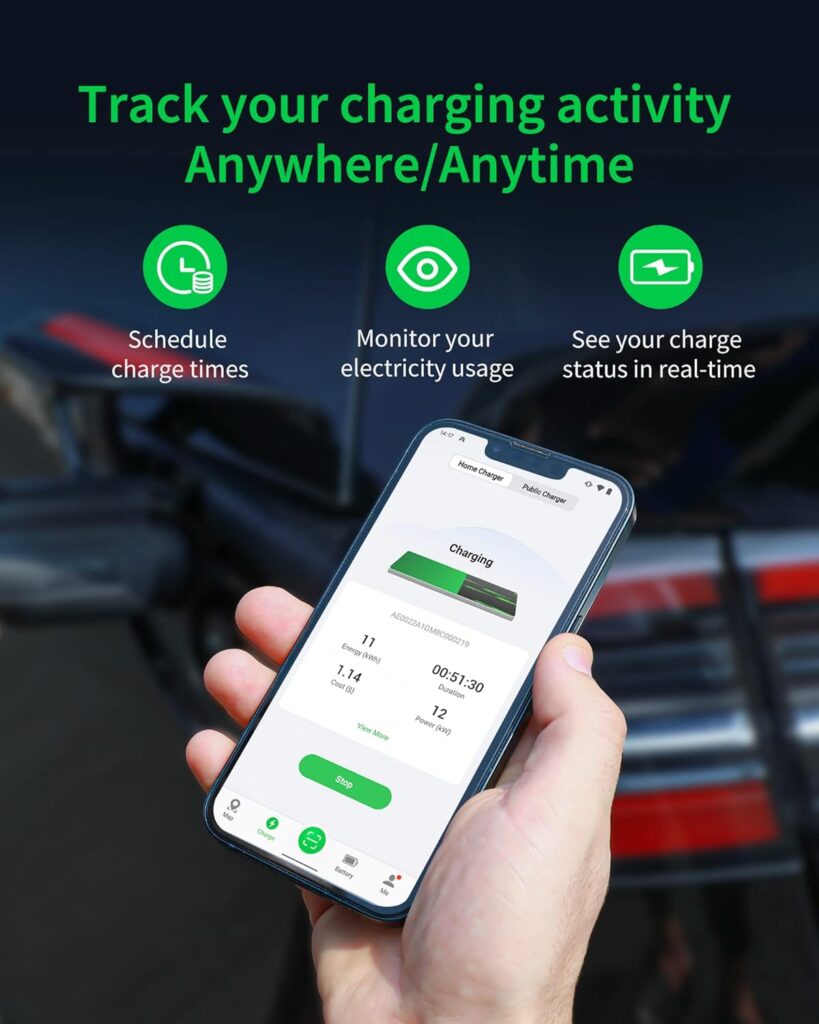
Autel MaxiCharger 50A Charger User Interface and Indicators - What Do They Mean?
The front of the charger has a ring of LEDs around the central button that gives you clear, at-a-glance status updates:
Solid Blue – Ready/Idle
The charger is powered on and ready to connect to a vehicle, or it’s finished charging.
Flashing Blue – Scheduled Charging
Charging is delayed until your scheduled time (e.g., during off-peak hours).
Pulsing Green – Charging in Progress
Everything’s working normally, and your vehicle is actively charging.
Solid Green – Charge Complete
Charging has finished, but the vehicle is still plugged in.
Flashing Red – Error or Fault Detected
There may be a grounding issue, overcurrent, overheating, or connection fault. Check the app for more info.
How durable is the Autel MaxiCharger 50A Charger? What is its expected lifespan? Are there any known reliability issues?
The Autel MaxiCharger is built like a tank. The outer shell is made from industrial-grade materials and has a NEMA 4 rating, which basically means it’s weatherproof. Rain, snow, dust – it can handle it. That makes it a solid pick whether you’re mounting it in a garage or outside on a wall.
Autel says this charger can last up to 13 years, which tracks for Level 2 units in this category. It comes with a 3-year limited warranty, which is about standard – not overly generous, but not stingy either.
The cable is long (25 feet) and thick, and while that means it’s a little stiff in colder weather, it’s clearly designed to hold up over time.
Known Autel MaxiCharger 50A Charger Issues from Real Users
No charger is perfect, and a few recurring complaints show up in user reviews and forums:
Wi-Fi/app glitches:
Some users mention that the app loses connection or doesn’t update in real time. Most of the time, restarting the app or the charger fixes it. Worst case, you reset your Wi-Fi settings and re-pair.Scheduled charging quirks:
The scheduling feature works, but it’s not always intuitive. If you don’t triple-check your settings, it might not start when you expect.Firmware update hiccups:
There are rare reports of firmware updates causing the charger to go unresponsive. Usually, a manual power cycle or contacting support sorts it out.
Discover the value of your cars options and specification!
- Select from thousands of vehicles and options
- See how each option adds value to your car
- Discover which tech features add a premium
- Spot which options hold their value over time
- Find out if that 'Sport' package pays off later
- Identify high value features others miss
£355 £354 £353 £352 £351 £350
What safety features does the Autel MaxiCharger 50A Charger Have?
The Autel MaxiCharger incorporates a comprehensive suite of safety features:
Over-current protection
Over-voltage protection
Under-voltage protection
Ground fault detection
Over-temperature protection
Surge protection
How much does the Autel MaxiCharger 50A cost in total, including installation?
Autel MaxiCharger 50A: Typically priced between $500 and $700, depending on the retailer and specific model.
Professional Installation: Installation costs can range from $300 to $800, influenced by factors such as the complexity of the installation, distance from the electrical panel, and local labor rates.
| Charger Model | Max Amps | Price Range | Notable Features |
|---|---|---|---|
| Autel MaxiCharger 50A | 50A | $500–$700 | 25-ft cable, smart app, NEMA 4 enclosure |
| Tesla Wall Connector | 48A | $420 | Tesla-specific, sleek design |
| Emporia EV Charger | 48A | $349–$429 | Wi-Fi enabled, energy monitoring, UL listed |
| ChargePoint Home Flex | 50A | $549–$599 | App integration, flexible amperage settings |
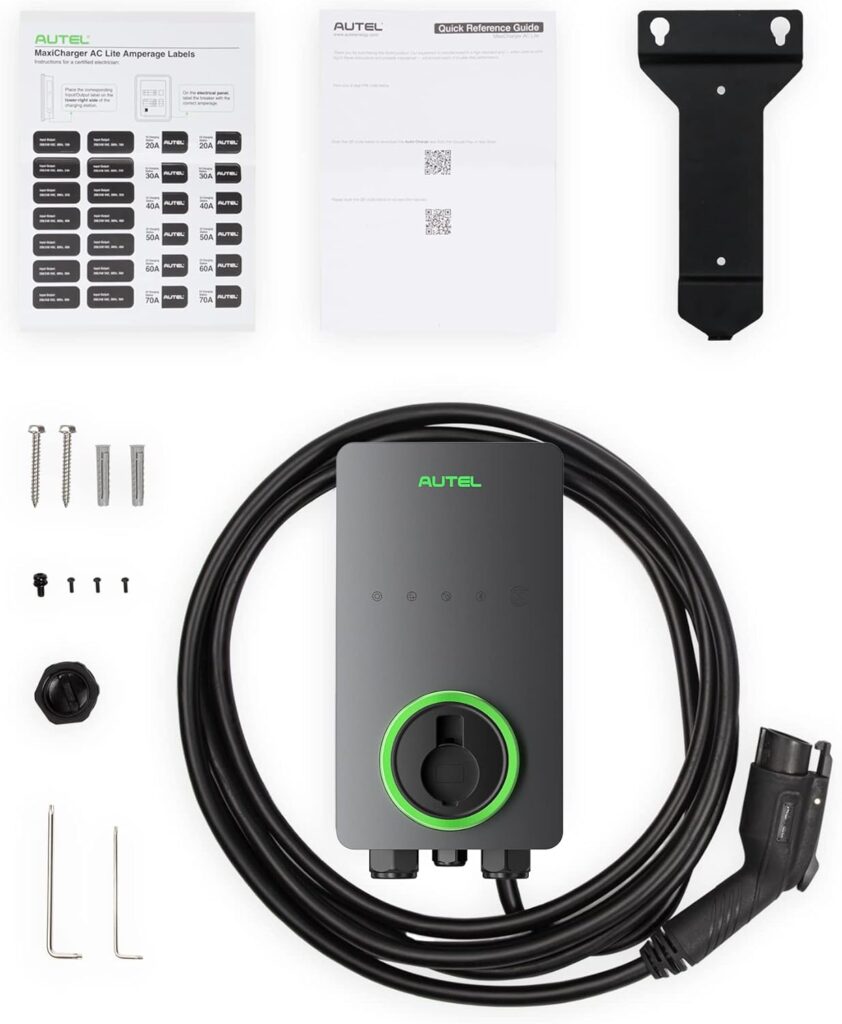
Are there any Autel rebates or incentives available for the Autel MaxiCharger 50A Charger?
Federal Incentives:
The Alternative Fuel Vehicle Refueling Property Credit offers a 30% tax credit on the cost of the charger and installation, up to $1,000 for residential installations. See Here
does autel have an eV charging network?
No, Autel does not have a publicly accessible EV charging network like ChargePoint, EVgo, or Electrify America.
While Autel manufactures EV chargers for both residential and commercial use, their primary focus is on hardware and software solutions for charging infrastructure. They provide the chargers, the management software, and related services, but they don’t operate their own network of public charging stations.
If you’re looking for public EV charging, you’ll need to use a network operated by other companies, such as those listed above. Autel’s equipment might be used in some of those networks, but Autel doesn’t directly manage the charging locations or billing.
How Do I Set Up The Autel MaxiCharger 50A Charger App?
Download and Install the App:
Find the App: Go to the App Store (iOS) or Google Play Store (Android) on your smartphone or tablet.
Search: Search for “Autel Charge” or the specific name of the app associated with your Autel EV charger. You can also scan a QR code on the charger itself or in the documentation to be taken directly to the correct app.
Download: Tap “Install” (Android) or “Get” (iOS) to download and install the app.
Create an Account or Log In:
Open the App: Once the app is installed, open it.
Account Creation: If you’re a new user, you’ll need to create an account. Tap the “Sign Up” or “Register” button.
Enter Information: Provide the required information, which typically includes:
Email address
Password (create a strong password)
Name (optional)
Phone number (optional, but may be required for verification)
Terms and Conditions: Review and accept the terms and conditions and privacy policy.
Verification: You may need to verify your email address by clicking a link sent to your inbox or enter a code sent to your phone number.
Log In: If you already have an account, enter your email address and password to log in.
Add Your Autel EV Charger
Add Device: In the app, look for a button or option to “Add Device,” “Add Charger,” or similar.
Select Charger Model: The app may prompt you to select your Autel EV charger model from a list. Ensure you choose the correct model (e.g., MaxiCharger 50A).
Connection Method: The app will typically guide you through connecting the charger to your Wi-Fi network. This usually involves one of these methods:
Scanning a QR Code: The charger may have a QR code on it (or in the manual). Use the app to scan the QR code.
Entering the Serial Number: You may need to manually enter the serial number of the charger, which is usually found on the charger itself.
Wi-Fi Direct Connection: The app might prompt you to temporarily connect your phone directly to the charger’s Wi-Fi network. This allows the app to configure the charger’s Wi-Fi settings.
Wi-Fi Configuration: Enter your home Wi-Fi network name (SSID) and password. The charger will then connect to your Wi-Fi. Make sure your Wi-Fi signal is strong where the charger is installed.
Configure Charger Settings
Charging Current: You may be able to adjust the maximum charging current (amperage) in the app. This is important if your electrical circuit has a limited capacity.
Scheduling: Set up charging schedules to take advantage of off-peak electricity rates.
Notifications: Configure notification settings (e.g., charging started, charging completed, errors).
Test the Connection
After setup, the app should display the status of your charger (e.g., “Idle,” “Charging”).
Initiate a charging session to verify that the app can communicate with the charger and control it.
Autel MaxiCharger 50A Charger Website Support
Official Website & Support Portal:
Website: https://www.autel.com/ (Start here for general information, product details, and the support portal).
Support Portal: [Search Autel support section in Autel.com] (This portal is likely where you’ll find FAQs, troubleshooting guides, software downloads, and other resources.)
Autel MaxiCharger 50A Charger - Phone Support
Phone Support:
North America (USA & Canada):
Check the Autel website for the specific EV Charger support number. You may find different numbers for different product lines (diagnostic tools vs. EV chargers). The general support number is: 1-844-248-3586 but verify if this is the best number to call!
Business Hours: Typically Monday – Friday, 9:00 AM to 6:00 PM Eastern Time (check the website for confirmation).
International: Visit the Autel website and navigate to the “Contact Us” or “Support” page. Select your region to find the appropriate phone number and business hours.
Important: Be prepared to provide your product model number, serial number, and a detailed description of the issue you’re experiencing.
Autel MaxiCharger 50A Charger - Email Support
Email Support:
General Inquiries: support@autel.com (Use this for general questions about Autel products, sales inquiries, etc.)
Technical Support: Use the support portal or the Autel website to find the specific email address for technical support related to EV chargers. There may be different email addresses for different product lines or regions.

Article By: Dale Ogden
Dale is a recognized expert in the automotive industry, known for his expertise in automotive asset management and consulting.
As the founder of Check Your Spec and former Forecast Manager at CAP HPI (equivalent to Kelley Blue Book in the USA) he made significant contributions to the development of forecasting strategies and depreciation models for internal combustion engines, hybrid, and electric commercial vehicles in the UK.
With over two decades of experience, Dale pioneered EV forecasting models that are now used by leading manufacturers.
His work has also produced residual values for over 10,000 new vehicles.
Autel MaxiCharger 50A Charger FAQ
What information should I provide if an error occurs on the AP200/HT200 code reader?
Serial Number of the Device: This is essential for identifying your specific code reader and its configuration.
Your Phone Details: Include the brand, model, and software version (e.g., Android 13, iOS 16) of your smartphone or tablet. This helps determine compatibility issues.
Screenshots or Video of the Error on the Device: Visual documentation of the error message or behavior provides valuable context for troubleshooting.
How can I transfer my software if I purchase a new AP200/HT200 code reader after my previous one was damaged/stolen?
Please contact Autel Support directly through their website or by phone. Provide proof of purchase for both the original and the new AP200/HT200 code readers. Autel support will be able to assist in transferring your existing software licenses to the new device. The process usually involves deactivating the software from the damaged/stolen device (if possible) and activating it on the new one.
Why am I unable to use PayPal or Apple Pay to purchase software/updates directly?
Autel’s payment system may have limited support for PayPal or Apple Pay directly within the app. Payment options are subject to change. Please check the payment screen in the app to see accepted payment methods. If those options are unavailable, consider purchasing an Autel credit card or contacting Autel support to check if there’s an alternate way to pay with your prefered method.
Why am I receiving an "Install Failed" error when attempting to download software?
This error message typically indicates a problem with Autel’s server or a temporary glitch in the purchasing process. Contact Autel support directly and provide them with the details of your attempted purchase (date, time, software you were trying to buy, and the serial number of your code reader). They can investigate the issue and help you complete the purchase. It may also mean that there is no more software available for that product so contact Autel to check.
I failed to purchase the software/update, but I received the message "The product has been moved."
Yes, but replacing the battery is expensive, typically costing $10,000–$15,000 depending on the battery type and labor costs. Ford’s warranty covers the battery for 8 years or 100,000 miles.
Why am I receiving an "Acquire Failed" error when I try to log in?
An “Acquire Failed” error during login can indicate a few potential issues:
Incorrect Credentials: Double-check that you are entering the correct email address and password associated with your Autel account.
Internet Connection Problems: Ensure you have a stable internet connection.
Server Issues: Autel’s servers may be temporarily down or experiencing technical difficulties. Wait a few minutes and try logging in again.
Account Issues: Your account may be locked or suspended due to inactivity or other reasons. Contact Autel support to verify the status of your account.
App Version: Make sure you are using the latest version of the Autel app.
What gauge wire should I use for a 50 amp EV charger installation?
Using the correct wire gauge is critical for safety and to meet electrical code requirements. For a 50-amp EV charger installation, you should use a minimum of 6 AWG (American Wire Gauge) copper wire.
Important Considerations and Explanations:
Copper vs. Aluminum: The 6 AWG recommendation is for copper wire. If you’re considering using aluminum wire (which is less common for EV charger installations due to its lower conductivity and increased risk of oxidation), you’ll need a thicker gauge, typically 4 AWG. Copper is generally preferred for EV charger circuits.
Circuit Breaker Size: While the EV charger is 50 amps, it’s crucial to have a circuit breaker sized at 125% of the continuous load, as required by the National Electrical Code (NEC). A 50-amp EV charger is considered a continuous load, so the circuit breaker should be 62.5 amps (50 amps x 1.25). The next standard breaker size up is typically a 60-amp breaker. Therefore, the wire gauge must be rated for at least 60 amps.
Distance (Voltage Drop): The length of the wire run from the electrical panel to the EV charger is also a factor. Longer runs can cause voltage drop, which can reduce charging efficiency and potentially damage the charger or your EV. For long runs (over 75 feet), you may need to increase the wire gauge to minimize voltage drop. Consult an electrician for guidance on voltage drop calculations.
Conduit: The type of conduit (or lack thereof) also affects the wire’s ampacity (current-carrying capacity). Wires installed in conduit may have different ampacity ratings than wires installed in open air.
National Electrical Code (NEC): All electrical work must comply with the National Electrical Code (NEC) and local building codes. The NEC provides detailed tables and guidelines for wire ampacity based on wire type, insulation, temperature rating, and installation method.
Licensed Electrician is Essential: Due to the complexities of electrical wiring and the importance of safety, it is strongly recommended to hire a qualified and licensed electrician for all EV charger installations. An electrician can assess your specific situation, determine the correct wire gauge, and ensure that the installation meets all applicable codes.
Wire Type: Use THHN or THWN-2 wire, which are commonly used for residential electrical wiring and are rated for 240V and 600V applications.
Ground Wire: Don’t forget the ground wire! The ground wire should also be copper and of the appropriate gauge (typically 10 AWG for a 60-amp circuit, but consult with your electrician).
Unlock accurate valuations for your car’s features in seconds – find out what your options are worth today and in the future.
